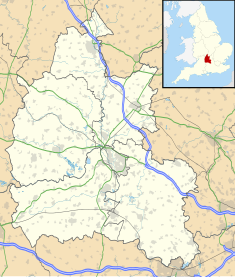Witney Town Hall is a municipal structure in Spring Lane in Market Square, Witney, Oxfordshire, England. The town hall, which is the headquarters of Witney Town Council, is a Grade II* listed building.[1]
| Witney Town Hall | |
|---|---|
 Witney Town Hall | |
| Location | Market Square, Witney |
| Coordinates | 51°47′02″N 1°29′07″W / 51.7839°N 1.4853°W |
| Built | 1786 |
| Architect | Sir William Chambers |
| Architectural style(s) | Neoclassical style |
Listed Building – Grade II* | |
| Official name | Town Hall |
| Designated | 14 May 1952 |
| Reference no. | 1213347 |
History
editThe first town hall in Witney was built in the Market Square in 1514.[2] The borough courts held hearings in the building from the mid-16th century and it was used for social events by the 17th century.[2] It was arcaded on the ground floor to allow markets to be held and an assembly room with was established on the first floor.[2] A village lock-up for holding petty criminals was installed in the arcaded area in the early 18th century and a horse-drawn fire engine was installed in the same area in the mid-18th century.[2]
Civic leaders decided to replace the town hall in the early 1780s. The new building was designed in the neoclassical style, probably by Sir William Chambers,[3] built in ashlar stone extracted from a quarry at Black Bourton by masons, James Gulliver and William Harris, and was completed in 1786.[2] The design involved a symmetrical main frontage with three bays facing onto the Market Square: the bays were divided by Tuscan order columns supporting the first floor structure and the meeting room on the first floor featured a large bay window facing onto Langdale Gate.[4]
The town hall became the main meeting place for vestry meetings in the late 18th century.[2] However, after the area was advanced to the status of urban district in 1895,[5] the new civic leaders decided to hold their meetings in the Corn Exchange, rather than the town hall.[2][a] Once the local borough courts ceased operating in 1925, the town hall fell vacant.[2] Ownership of the building passed to a body known as the Town Hall Charity in 1929,[4][8] and, following the change of ownership, alterations, which involved filling in the left hand arcade, were carried out to a design by Thomas Rayson in 1930.[2] The work also included installation of public toilets on the ground floor, the fitting of a new staircase and the removal of the bay window on the first floor.[2]
Following the local government re-organisation in 1974,[9] which saw the abolition of Witney Urban District Council, the new parish level body, Witney Town Council, chose to refurbish the town hall at a cost of £15,000 and made the building its main meeting place.[2][10] These works also saw the removal of the public toilets on the ground floor and the creation of a town clerk's office.[11]
Notes
edit- ^ Witney Urban District Council relocated from the Corn Exchange to a large Victorian era property at 26 Church Green in 1936.[6][7]
See also
editReferences
edit- ^ Historic England. "Town Hall (1213347)". National Heritage List for England. Retrieved 25 April 2021.
- ^ a b c d e f g h i j k Baggs, A. P.; Chance, Eleanor; Colvin, Christina; Cooper, Nicholas; Crossley, Alan; Day, Christopher; Selwyn, Nesta; Williamson, Elizabeth; Yates, Margaret (2004). "'Witney borough: Introduction, Architecture and Buildings', in A History of the County of Oxford: Volume 14, Bampton Hundred (Part Two), ed. Simon Townley". London: British History Online. pp. 33–68. Retrieved 25 April 2021.
- ^ Jenkins, Stanley (2012). Witney Through Time. Amberley Publishing. ISBN 978-1445609492.
- ^ a b "Witney Town Hall" (PDF). Witney Town Council. Retrieved 25 April 2021.
- ^ "Witney UD". Vision of Britain. Retrieved 25 April 2021.
- ^ Baggs, A. P.; Chance, Eleanor; Colvin, Christina; Cooper, Nicholas; Crossley, Alan; Day, Christopher; Selwyn, Nesta; Williamson, Elizabeth; Yates, Margaret (2004). "'Witney borough: Local Government, in A History of the County of Oxford: Volume 14, Bampton Hundred (Part Two), ed. Simon Townley". London: British History Online. pp. 111–130. Retrieved 25 April 2021.
- ^ "No. 38920". The London Gazette. 23 May 1950. p. 2577.
- ^ "The Town Hall Charity". Charity Commission. Retrieved 25 April 2021.
- ^ Local Government Act 1972. 1972 c.70. The Stationery Office Ltd. 1997. ISBN 0-10-547072-4.
- ^ "Witney Town Council leader Dean Temple facing no confidence vote". Oxford Mail. 25 October 2018. Retrieved 25 April 2021.
- ^ "Witney Town Council". West Oxfordshire District Council. Retrieved 25 April 2021.
